Page 2


Page 2

BRIANA BRADY STAFF WRITER
Champlain Valley School District and the surrounding communities continue to feel the impact of changes in processes and attitudes toward immigration at the federal level.
On Friday, the district learned that a kindergartener and their family are planning to leave the country and return to Ecuador. This is in addition to two high school students who are choosing to leave after President Trump ordered the end of humanitarian parole protections for Cubans, Nicaraguans, Venezuelans and Haitians.
The high school students, who are from Nicaragua, were informed by the U.S. Department of Homeland Security that they would face deportation if they stayed in the country beyond the end of the month.
Although a judge in Boston put a stay on the order, the two seniors are still choosing to leave rather than face an uncertain future. Christina Daudelin, a student and community engagement facilitator with the district who has been organizing support for the students, said that, similarly, this kindergartener and their family are choosing to leave.
Unfortunately, she said, this puts them in a precarious financial situation.
“Due to the significant cost of coming to the U.S. and now having to leave, the family could use the support of our commu-
See IMMIGRATION on page 12

Home
Page 10
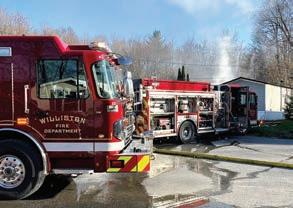
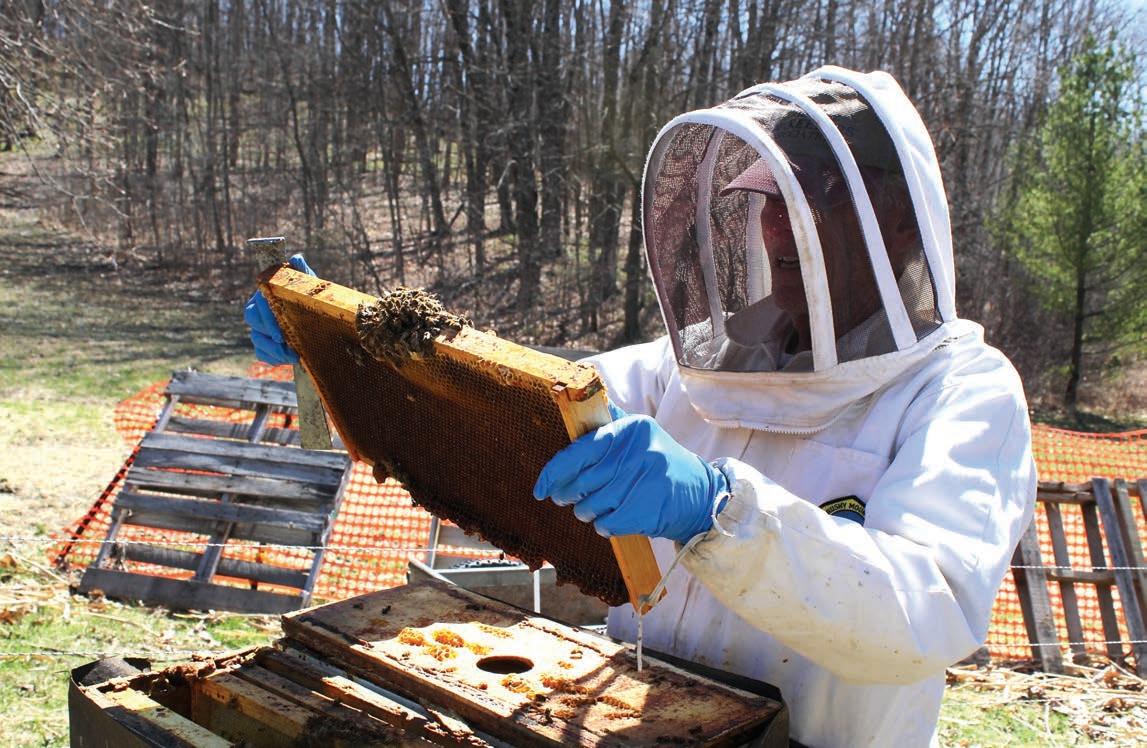
Outfitted in his white jacket and mesh hood, Ken Brown levered open the top of one of his hives last Thursday. The insects buzzed peacefully around his arms. Brown keeps bees in his backyard in Hinesburg, and he was checking to see how many of his bees had survived the winter.
Brown bought his first two hives for $25
in 1988 from his home’s previous owner. The bees have been buzzing in his yard ever since. Now, he has 31 nuclei, or nucs — mini-colonies that are partially developed. Brown raises and cares for the nucs before selling them, mostly to small-time beekeepers who might harvest honey from a few hives that they keep in their yards. This year, he had a pretty good survival rate. As he checks the hives, he repositions the bricks holding down the tops.
“The hives where the brick is upright, I’ve seen enough activity to feel confident that the bees are surviving. My count is about 24 out of 31.”
Brown’s survival rate is much higher than what other beekeepers have been seeing across the country. According to Project Apis m., a nonprofit focused on honey-
See BEES on page 8


BRIANA BRADY STAFF WRITER
As attendees at the input session on Vermont’s new climate action plan used their phones to answer a live survey last Tuesday about their personal experiences with climate change, the growing number of words populating the screen at the front of the room reflected the anxieties of a group whose lives have already been altered, in big and small ways, by a changing climate.
David Plumb, a mediator working with the Vermont Climate Council on the rewrite of the state’s climate action plan, read some of the submissions from the crowd aloud.
“It’s about the flooding. It used to snow more. I’m feeling concerned about my grandchildren. Earlier tapping for maple sugaring. It’s really frustrating in terms of budgeting for our communities. We’ve been seeing drought. Summers are too hot,” Plumb read.
The meeting, which was held in the Champlain Valley Union High School cafeteria and attracted around 90 attendees, was the second of seven in-person sessions the climate council is holding before the end of the month. The council is collecting feedback on the current draft of the plan, which will be adopted on July 1 of this year.
The first climate action plan was enacted in 2021 following
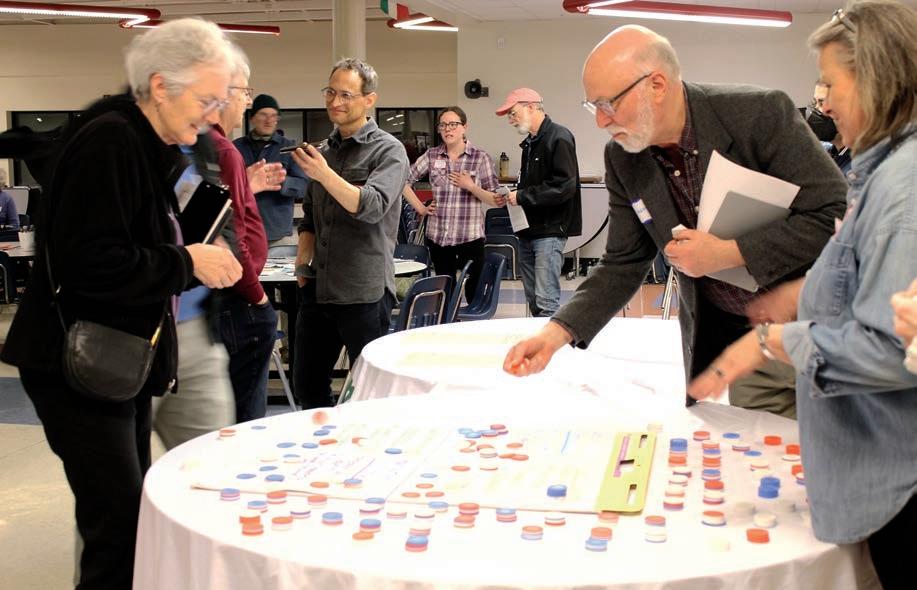
the Global Warming Solutions Act, which legally required the state to reduce greenhouse gas emissions by 40 percent of 1990 levels by 2030. The Vermont Climate Council, which oversees the formation of a new action plan every four years, is made up of 23 people purposely appointed to represent different sectors such as farming, the energy industry or scientific research.
The drafted plan, as it stands
now, is broad. Meeting attendees were asked to review 56 different priority actions that the council is considering for the 2025 update. Those priorities fall into a range of categories including transportation, building, workforce development, planning, and climate-resilient land.
According to Jane Lazorchak, the director of the state’s Climate Action Office, 40 percent of emissions in Vermont come from
Enjoy a heartwarming Mother’s Day brunch featuring live music, fresh flavors, and cherished moments with the ones who matter most in our beautiful atrium.

SUNDAY, MAY 11
TWO SEATINGS ( 10:30-11:00 AM & 1:30-2:00 PM )
ADULTS $65 | AGES 5-12 $28 | UNDER 5 FREE Prices do not include taxes and gratuity.

term, but it’s coming somewhat faster than I think any of us could have understood or expected, and so some of the solutions you’ll see tonight as recommendations contemplate new ways to raise revenue,” she said.
Plumb acknowledged that each person might not be able to thoroughly read through all 56 priorities, but asked participants to take note of what they liked and what they didn’t.
“Question number one, what’s compelling here, what’s most important here? Question number two is, what is the urgent feedback you have for the council right now?” Plumb said.
In the plenary discussion, the concerns from different attendees often mirrored their experiences.
“Over the last year, last two years, on July 10, we’ve had two 100-year floods, and we’re anticipating another one this year. It seems to come up right after July 4. So we don’t have time to waste. We need to do stuff that’s big,” one attendee from Richmond said.
transportation. This is followed closely by the amount from heating homes and commercial buildings, making climate solutions around those issues a focus of the council.
Lazorchak also noted that some of the solutions were focused on funding. Last year, she said, 80 percent of the $350 million earmarked in the state budget for cutting climate pollution came from federal funds.
With the Trump administration cutting federal funding across the board, it is unlikely that the state will be able to continue to rely on federal money.
“We knew this day was coming, to think about the responsibility of how we fund that long
Those floods in Richmond and in Hinesburg, as well as the flooding in central Vermont two years ago, were declared disasters by the Federal Emergency Management Agency. For the early July flooding last year alone, the agency provided more than $11 million in individual assistance to help aid in repairs.
The Town of Hinesburg, which saw culverts washed out and roads destroyed, is still in the process of securing FEMA funding for repair work.
Other concerns came out of work and professional experience.

• Made-To-Order Omelets with Fresh Ingredients
• Classic Eggs Benedict
• Carving Stations with Salmon and Prime Rib
• Build-Your-Own Waffle Bar Served with Pure Vermont Maple Syrup
• Baked Pastries and Seasonal Desserts

Major Charlotte connector route had been shut to traffic after major flooding wiped out culvert
LIBERTY DARR STAFF WRITER
Nine months after statewide flooding devastated Spear Street, a major connector route in Charlotte, town officials say the repair work is almost done and, as of now, back open to traffic.
Charlotte saw nearly 5.3 inches of rain overnight on July 10 last year and a 10-foot by 60-foot culvert on Spear Street was washed away, leaving the road completely unpassable. Additionally, roughly 10 feet of the road just south of the culvert that channels Muddy Hollow Brook eroded when the ground became oversaturated by the torrential rains.
The selectboard opted to fix the road with a dual culvert and received the green light from the Vermont Agency of Natural Resources to move forward with the project in November.
While Lewis had been involved in opening the construction bids and giving advice on picking each contractor, the work done on Spear Street was separate from his work for the town.
“Our contractors have set the culverts.
The concrete has been placed. It’s been backfilled with gravel. The only thing that we’re waiting on at this point is the paving of the site, as well as some site cleanup on the east side of Spear Street,” town administrator Nate Bareham said.
“Everyone really came together to make sure that this was happening.”
The paving work, Bareham said, is the only part of the project that will not be reimbursed, since the town was unable to complete that work by the deadline. That is mostly due to paving contractors who don’t operate until late spring.
— Nate Bareham
The selectboard engaged two separate contractors to complete repairs. Poulin Companies LLC, a civil construction firm in Burlington, was hired to complete the culvert replacement for just over $555,000 and Dirt Tech LLC, a construction company from Colchester, completed the slope stabilization for $272,000.
While the town had to pay out of pocket for the project just over a million dollars, nearly all the money was reimbursed through the Federal Highway Emergency Relief Program. However, under the guidelines, the town had a strict timeline for completing the work. The program stipulated a completion of 270 days from the emergency event, putting the town on a deadline of April 6.
Right after the flooding, town road commissioner Junior Lewis preemptively purchased both culverts for the repair, which was also reimbursable with federal money.
continued from page 2
“I didn’t see anything in regards to protecting outdoor workers. It may seem like a sort of a side thing, but we have a lot of outdoor workers in Vermont. I’ve been that myself, many times. I have a particular sense of what it’s like, and it’s construction workers, rec department workers, road workers, it’s farm workers, it’s kids having fun,” Steve Crowley of South Burlington, said, raising concerns about workers well-being in rising heat. Crowley is director of the Vermont Community Solar Association.
More comments focused on land conservation, home weatherization, and building regulations as towns work to build more housing to meet new targets. One of the big takeaways, however, was interest in cap and invest programs, which would require businesses to purchase allowances
The roughly $37,000 paving cost will be incorporated into the town’s paving budget for the current fiscal year. Bareham anticipates the road will again be temporarily closed once paving begins in the next month.
“The way that we’ve historically done paving is the town will usually receive bids for general paving projects. We budget for that annually with the assumption that that cost will hit the town in May or June, right before the fiscal year closes,” Bareham said.
“So, we already planned for expenses related to paving. We’ll basically do a little bit less painting this year than we typically would for other roadways, and we’ll incorporate that cost into our paving budget.”
Bareham said that, despite some lingering costs, the entire project — one of the largest unplanned capital projects the town has ever dealt with — was a success and testament to the efficiency of town staff.
“Everyone really came together to make sure that this was happening and happening quickly,” he said.
when emitting greenhouse gases beyond a set cap.
As presented in the draft, after preparatory studies, the cap and invest program would first focus on the transportation fuel sector. The funds raised through allowances might help close the gap created by any pullback in federal funding.
Whatever final form the draft ends up taking, Beth Sacks of Burlington asked that the state government take the plan seriously.
“I think the first thing we need to do is honor the plan,” she said. “We need to recognize it’s not aspirations. We need to follow it, and we need to make sure that the measures add up to the goals that we set. I also think we have to get serious about mandates and having government play the role that it needs to play.”


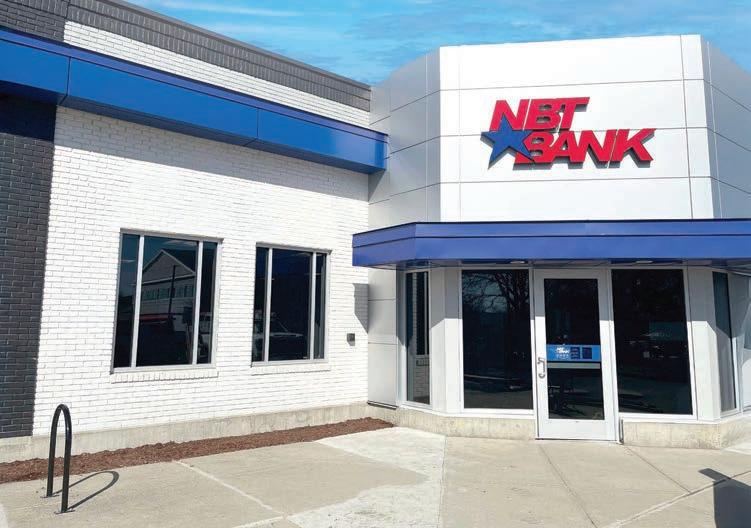
Let us show you how we go the extra mile to be your top choice for banking:
• 24/7 Account Balance and Transaction Monitoring
• Send Money to Friends and Family with Zelle®
• Convenient Mobile Check Deposits
• Enhanced Fraud Protection and Text/SMS alerts
• User-friendly Online Bill and Loan Payments
• Enroll in Direct Deposit to Automatically Deposit Paycheck
Jenna.Boiney@nbtbank.com We can’t wait to meet you.
Chris Walker Branch Manager 802.341.8848
Chris.Walker@nbtbank.com
Jenna Boiney Senior Relationship Banker 802.341.8848
Chris Cannata Senior Relationship Banker 802.341.8848 Christopher.Cannata@nbtbank.com
Open an account online or visit your local NBT branch today. It only takes minutes to start banking better.
www.nbtbank.com
Total incidents: 29
Traffic stops: 13
Incidents:
April 15 at 9:04 p.m., officers responded to a domestic dispute on Green Street.
April 16 at 9:49 a.m., police investigated suspicious activity on Silver Street.
April 16 at 1:24 p.m., an officer assisted Howard Center Community Outreach with a juvenile issue on Leavensworth Road.
April 16 at 2:34 p.m., police conducted a welfare check on Gilman Road.
April 17 at 6:30 a.m., police investigated suspicious activity on Richmond Road.
April 17 at 4:35 p.m., police investigated a trespassing issue on North Road.
April 18 at 6:42 a.m., an officer investigated a report of a theft of property on Wile Street.
April 18 at 8:40 a.m., police investigated a burglary alarm on Abani Drive.
April 18 at 10:05 a.m., police conducted a welfare check on North Road.
April 18 at 6:53 p.m., an officer assisted first responders with a medical emergency at Champlain Valley Union High School.
April 18 at 6:55 p.m., police investigated an alarm activation on Commerce Street.
April 21 at 7:00 a.m., police investigated a report of a citizen dispute on St. Cyr Lane.
April 21 at 12:41 p.m., an officer assisted first responders with a medical emergency on Aube Ridge Road.
Note: Charges filed by police are subject to review by the Chittenden County State’s Attorney office and can be amended or dropped.
Serving the community of Charlotte & Hinesburg A publication of Vermont Community Newspaper Group LLC thecitizenvt.com
Advertising Wendy Ewing wendy@shelburnenews.com (802) 238-4980
Advertising Director Judy Kearns judy@otherpapersbvt.com (802) 734-2928
Editor Tommy Gardner tommy@stowereporter.com (802) 253-2101 x25
Staff Writers
Aaron Calvin Liberty Darr
Patrick Bilow Briana Brady
Production/Design
Stephanie Manning stephanie@shelburnenews.com
Kristen Braley kristen@stowereporter.com
General Manager Katerina Werth katerina@stowereporter.com
Billing inquiries Leslie Lafountain leslie@stowereporter.com (802) 253-2101
Advertising submission deadline: Friday at 5 p.m. advertising@thecitizenvt.com classifieds@thecitizenvt.com
Editorial submission deadline: Friday at 12 p.m. news@thecitizenvt.com
Calendar submission deadline: Friday at 12 p.m. news@thecitizenvt.com
Contact: PO Box 489 Stowe, VT 05672 (802) 253-2101
Cell phones are made to hijack attention
To the Editor:
Dear members of the Champlain Valley School District board, thank you for the opportunity to share my thoughts as a parent, educator and community member.
With over two decades in education and a child soon entering high school, I strongly support a bell-to-bell phone-free school day across our district. This isn’t about restricting freedom, it’s about providing structure and boundaries that help students thrive academically, socially and neurologically.
While I value the student voices asking to be trusted, we must remember that adolescence is a time of intense brain development. The prefrontal cortex — responsible for decision-making, emotional regulation and impulse control — is not fully developed until the mid-20s. Phones exploit
this vulnerability. They are engineered to hijack attention, using the same neural pathways as addictive substances.
Even responsible phone use adds cognitive load, diminishes working memory and reduces learning retention. A 2017 educational psychology study found that simply having a phone nearby during a learning task reduces performance. Multiply that across a school day, and the cumulative impact on focus and comprehension is profound.
From a safety perspective, phones can create chaos in emergencies. Pinging alerts and mass texts spread misinformation and hinder coordinated responses. Crisis protocols depend on clarity, not confusion. Trained staff and established procedures are far more effective than hundreds of individual responses.
Emotionally and socially, these years are vital for developing communication, conflict resolution and self-regulation.
Phones fragment attention and reduce face-to-face interaction — essential life skills that need consistent daily practice. We must help students protect their own growth from constant digital disruption.
This isn’t generational panic. It’s about creating an environment where students can take a break from the relentless pull of technology, just six or seven hours a day where their nervous systems can settle and relationships can grow, where curiosity can deepen, and authentic connection can take root.
I support this policy not only as protection, but as liberation. The school day should be a sanctuary for focus, connection and creativity. Phones have a place — but not bell-to-bell.
Thank you for your time, leadership and care for our students.
Peggy Dippen, M.Ed. Hinesburg




Grand Senior Living is now welcoming residents! Enjoy a vibrant lifestyle in downtown Vergennes, with enriching activities, stunning Adirondack views from our Grand Dining Room, and a warm, welcoming community.
North Street, Vergennes, VT



In a recent op-ed about the Global Warming Solutions Act, Vermont’s cornerstone climate policy, Agency of Natural Resources Secretary Julie Moore accused legislative leadership of being “content” with “unattainable” climate pollution reduction requirements. As Chair of the Senate Committee on Natural Resources and Energy, I feel compelled to respond, as I would not describe us as content with the current situation.
Earlier this year, I presented the administration with a potential path forward, an offer that still stands. But before I get into the details, let’s clarify one important point. The next major Global Warming Solutions Act deadline isn’t tomorrow. It’s in 2030 — five years from now.
Five years to act. Five years to take meaningful steps toward reducing climate pollution, which will ultimately save Vermonters a significant amount of money.
Unfortunately, based on the pattern we’ve seen, I don’t believe Gov. Phil Scott will do what’s necessary. Instead, he’ll continue to do what he has done on climate: stall, resist and let the Legislature do the heavy lifting, only to blame us when we propose real solutions that would lead Vermont toward a cheaper, more sustainable and resilient energy future.
I’m interested in solutions, and I believe Vermonters are too. It’s unclear to me, though, how interested the governor is in finding solutions.
By 2030, Gov. Scott will have had an entire decade to implement policies to meet our climate targets. While I recognize and appreciate his support for the Clean Cars and Trucks rules, that alone falls short of what this moment demands. Unfortunately, it remains unclear what further policies the governor is actually willing to support. The governor’s package of climate rollbacks (H.289) requires an “implementation strategy” for reducing climate pollution, but it’s not due until December 2026, after this bienni-
um is over and, conveniently, after the next election.
Just to clarify, the governor doesn’t need a new bill to make an implementation plan. We already have an actual law: the Global Warming Solutions Act. If Scott wasn’t willing to act based on the directive of current state law, it’s difficult to trust that a new law would compel him to do so.
That’s why I proposed the following path forward.
First, the governor must identify and commit to a real strategy, something that moves us meaningfully and substantially toward the 2030 pollution reduction requirement, something that gets Vermonters to the cheaper, more price-stable, more self-sufficient and resilient future that we all want.
Second, the governor should roll it out and start implementation in 2026 or 2027. Third, prove to us it’s working in 2027 or 2028.
Then, and only then, we can talk about recalibrating the time-
See WATSON on page 16
Guest Perspective
Miro Weinberger
If you’ve turned on a podcast, watched a late-night show, or scrolled social media in the past month, you’ve probably heard something about “Abundance,” the new book by Ezra Klein and Derek Thompson. The thesis is simple yet powerful: America, especially in blue states, has over decades created systems that prioritize stopping things rather than building them. We’ve become experts at saying no.
“Abundance” has struck a nerve — for good reason. It is a call to action, a challenge to break free from what the authors describe as “the politics of blocking.” It’s about a country that’s forgotten how to build: homes, transit, clean energy the infrastructure of opportunity.
Sometimes Vermont can seem
insulated and removed from national political conversations, and it can be easy to think some of these discussions don’t apply here. We pride ourselves on being a little different, a little apart.
But this one? This conversation is 100 percent about us.
When Klein says we’ve built a political system that’s better at stopping things than getting them done, he could be talking about Vermont’s housing shortage. We’ve created a system that makes it incredibly hard to build the homes we need. Our state faces a critical housing shortage, yet the pathways to create more homes are gauntlets of redundant state and local rules, costly government mandates and a permit appeals systems that enables obstructionists.
As a result, the average Vermonter experiences soaring rents, impossible home prices and a growing number of neighbors



without secure housing.
We started Let’s Build Homes to ensure this isn’t Vermont’s future. We are working to transform our state from one that excels at blocking to one that prioritizes building in the right places, and we are already having an impact.
In this legislative session, we’ve supported a bill that will make it easier to finance and build the infrastructure — like water, sewer and roads — that makes new housing possible. Thanks in part to our testimony and the coalition members who contacted their legislators, this bill has now passed the Senate. We are also working directly with municipalities to modernize zoning and allow more housing in the places where it’s most needed. Next, by engaging the process launched by the Legislature a year















Guest Perspective Jack Hoffman
Now that the House has passed an education reform plan, it will be easy to get bogged down in the minutiae that differentiate it from Gov. Phil Scott’s “Education Transformation Proposal.” But before Vermonters get lost in the weeds debating these proposals, they might want to ask themselves if they support the radical change that both plans represent:
The biggest flaw is that the wealthiest Vermonters are taxed on their home value, not their income.
• Are they ready to abandon the idea that taxation for public education should be based on residents’ ability to pay and that a person’s income is the fairest measure of that ability?
• Are they ready to take control of education spending away from local voters and cede it to the Agency of Education?
For more than 25 years, the funding system has recognized that taxing people according to ability to pay was the fairest way to share the cost of educating our children. And a homeowner’s income, rather than the current selling price of the house, has been viewed as a more accurate measure of a person’s ability to pay taxes.
Under the current system, about two-thirds of resident homeowners pay some or all their school taxes based on their income. There are problems with the current system, despite efforts to go to a simple income-based school tax for all residents. But the biggest flaw is that the wealthiest Vermonters are taxed on their home value, not their income. That means the wealthy pay less of their income to support education than do typical homeowners making $80,000 or $90,000 a year. The wealthiest 30 percent of homeowners get about 60 percent of Vermont’s adjusted gross income, but don’t pay school taxes based on that income.
Instead of addressing this imbalance, both the administration and the House want to revert to a property-based school tax system, locking in this break for wealthy homeowners.
The administration and House each propose some form of “homestead exemption.” The exemptions would be tied to household income and exclude a portion of home value from
See HOFFMAN on page 7










Beth Parent
With Green Up just around the corner, it’s the perfect time to reflect on the small actions we take that add up to a big impact — like recycling.
Have you ever paused before tossing a box or plastic bottle in the blue bin and thought, “Is this really going to be recycled?” You’re not alone. In a world where national headlines question the integrity of recycling, it’s easy to feel skeptical.
We certainly cannot speak to what happens in other states, but we can say with certainty here in Chittenden County, your recycling matters, and it works.
At the Chittenden Solid Waste District, we sort and ship your recyclables to real markets where they’re turned into new products. Our Materials Recycling Facility in Williston is where the magic happens. Once your blue-bin items are collected and sorted there, they are then sold to buyers
continued from page 6
taxes. But adjusting house values according to the owner’s income bracket is not the same as taxing income. The market value of the house, not the homeowner’s income, would ultimately determine the tax.
Homeowners on fixed incomes would once again be vulnerable to changing real estate prices. And homeowners with the same income but different house values, in districts with the same per-pupil funding, would not pay the same taxes, as they do now.
The governor and Legislature complain that Vermont spends too much on education for the results it gets, although some districts are criticized for not spending enough. The feeling is that local voters don’t make sound spending decisions, even though they are voting on their own taxes and how to spend the state’s (i.e. their own) money.
Recent reforms were supposed to save money and improve student performance: school consolidation, a new special education funding formula, a new weighting system to direct funding to certain students. But when education spending jumped this year — because of Covid, inflation, healthcare and mistakes in implementing the new weights — it provided Montpelier an
across North America.
Here’s a quick look at what your blue bin recyclables become once they leave your curbside:
• Cardboard and paperboard are sent to places like Kruger Inc. and West Rock, where they’re transformed into new cardboard boxes and paper towel cores.
• Glass bottles and jars are ground and repurposed locally by Glass2Sand and Whitcomb Construction into road base and concrete block mix.
• Plastics #1, #2, and #5 are shipped to companies like KWP Plastics, Envision Plastics and Mohawk Industries, which turn them into new beverage containers, fleece jackets, carpet and even drainage pipes and paint buckets.
• Aluminum and steel cans are melted down at NH Kelman Inc. and reappear as rebar, bikes, appliances, baseball bats and, yes, new cans.
Recycling only works when it’s done right, and Chittenden County residents are part of Vermont’s success story. But to
keep that going, we need your help. The most critical part of recycling happens before materials reach our facility — right in your blue bin.
Sorting correctly, knowing what goes where, and staying updated on changes to accepted materials ensures we can continue to operate efficiently, ethically and sustainably.
In fact, understanding what happens after the bin can transform the way we see waste. We stop thinking of it as “trash” and start seeing it as raw materials that are made into something new. Let’s keep working together to make sure our recycling system remains strong, transparent, and trustworthy. Your blue bin is not the end of the line—it’s the beginning of the next cycle. Together, we can make recycling something we’re all proud to stand behind.
Beth Parent is the community engagement and outreach manager at the Chittenden Solid Waste District.




opportunity to change the funding system and take away local voters’ control.
The Legislature and the governor want further consolidation despite the failure of Act 46, the first consolidation law, to achieve promised results. The governor proposed five mega-districts. While that was too few for the House, 20 might be enough. But large districts, coupled with the new approach to funding, may further alienate voters and discourage democratic participation.
The governor and House each proposed foundation-type funding systems. Essentially, a per-student “foundation amount” would be allocated to all students. The foundation grants may be supplemented for students needing additional funding.
But whether it’s the governor’s model or the Legislature’s, we can expect the actual calculation of the foundation amount and ancillary adjustments to be generated at the Agency of Education by a consultant-designed computer program, not unlike the database and program used to generate Vermont’s new pupil weighting system a couple of years ago.
A single, base amount of funding that works across the state
seems to fly in the face of what we learned about cost increases districts incurred this year. Staffing shortages and demand for mental health services, for example, hit some budgets harder than others. How would a foundation amount allow for that kind of variability or the preferences of Vermont’s diverse communities?
The governor and Legislature are pressing ahead with a new tax and funding system long before the Commission on the Future of Public Education in Vermont has completed its work or even heard from people across the state. They are pressing ahead without fixing the unfairness of the current system that favors wealthy homeowners. And they are pressing ahead even though a foundation formula, while it may reduce funding to schools, doesn’t reduce the costs that drove up education spending this year.
If the past decade of reforms taught us anything, it’s that these big changes don’t always live up to their promises and come with unintended, often negative, consequences.
Jack Hoffman is Senior Analyst at Public Assets Institute (publicassets.org), a non-partisan, non-profit organization based in Montpelier.





continued from page 1
bee research, 2025 has seen huge losses in honeybee colonies so far. In a survey of 702 respondents, the organization found that commercial beekeepers had lost, on average, 62 percent of their colonies. While a certain amount of loss is normal, the loss rate is usually around 25 or 30 percent. Sometimes bees run out of food over the winter, causing a colony to starve, but they can also be waylaid by diseases and parasites.
In Vermont, however, most of the bees are just coming out of their overwinter cluster where they gather, vibrating to keep warm, so experts still don’t know how many have survived statewide. This past winter went particularly long — Brown is usually checking on his bees around April 10 when his lawn is covered in dandelions. This year, the dandelions had yet to pop up from the ground as he moved around his hives.
Brooke Decker is a pollinator health specialist and apiculturist for Vermont’s Agency of Agriculture. Before people with sideline businesses like Brown can sell their nucs, it’s Decker’s job to check on their hives, screening for disease and other issues .
“Most of the nucleus colonies that are sold in the state are sold within the next, I’d say, six weeks. So we hit the ground absolutely running, like on fire. We’re trying to look at as many nucleus colonies as absolutely possible,” Decker said.
As she checks on nucleus colonies, Decker gets a sense for where bee health and survival rate is at throughout the state. Although she is just beginning to screen bees this year, she’s already hearing from some beekeepers.
“I’m hearing very mixed stories in Vermont, some people with really high losses, some people that had a lower loss year and a higher success rate than years past. So, it’s really all over the place,” Decker said.
Every year, she said, the agency surveys apiaries and beekeepers
about how their hives and colonies are doing. So far this year, she said, because it’s so early in the season, they’ve only had 80 responses to far, out of a possible 800. So while she said that so far they’re seeing losses on par with national numbers – about 62 percent – that comes with a grain of salt until they have more data.
From the responses she has seen, though, a few things stand out.
“The biggest issue that we see in living and dead colonies are impacts of this varroa mite, which is a parasite of the honeybee that eats some of its nutrition, you know, the feeds on the fat bodies and also vectors diseases,” Brooke Decker
The third nuc Brown opens up at his apiary has a cluster of dead bees crowded near the hole at the top. He scraped a few of them into a small plastic jar and screwed on the lid.
“I’m gonna take these to the Bee Lab,” he said.
The Bee Lab, located at the University of Vermont, does research and outreach related to pollinators. One of the lab’s projects is their diagnostic clinic, where they offer free testing to local beekeepers for varroa mites as well as nosema, a disease caused by another parasite.
“We do end up getting a flood of samples in the spring, as beekeepers are checking their overwintering success and trying to figure out how they might better prevent colony loss going forward,” Sydney Miller, lead research technician at the Bee Lab, said.
The lab, Miller said, has been growing in the last few years. They process around 100 samples a year, but have been doing more and more every year. Last year, it saw a 30 percent increase in the number of apiaries it received samples from. Doing the testing means they get baseline data for which diseases are impacting Vermont’s bees.
“The Diagnostic Clinic is a little bit biased, because, of course,
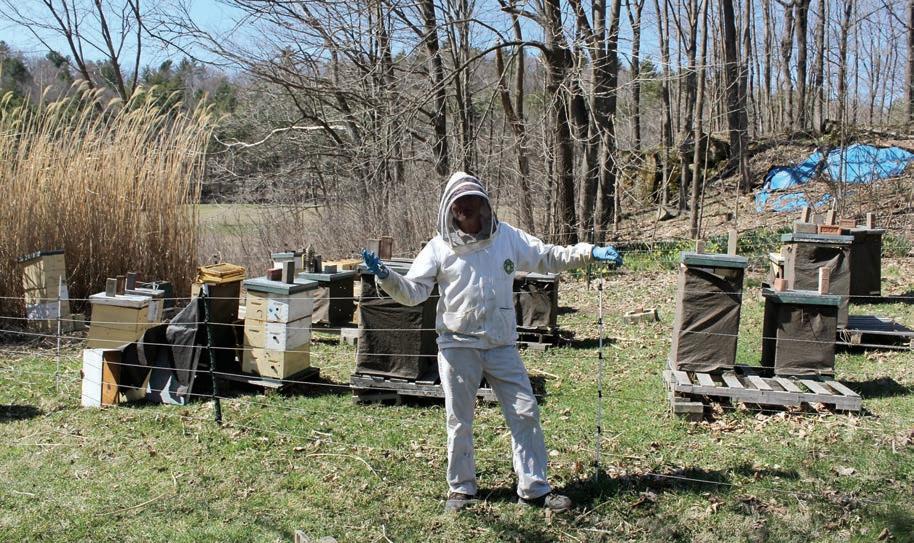
we’re usually receiving samples from beekeepers that are submitting their sick bees because they want to understand why they died, or why they’re seeing these symptoms,” Miller said.
While, like Decker, Miller doesn’t have any hard data yet, she’s been in contact with a lot of beekeepers.
“Just kind of anecdotal evidence from my personal communications with commercial beekeepers, it’s been a really rough year for them,” she said.
According to Decker, while native bees are a cornerstone of pollination around the state, honeybee operations can provide an important service to local agriculture. For apple and berry farms, they may bring in bees from an apiary to help pollinate their crop, or, if they live close enough to apiaries, they may not need to worry about pollination at all. Decker said that in Chittenden County in particular, where beekeeping is dense, many gardeners or farmers may passively benefit from the local bees.
Although things may not look good for many beekeepers this year, Brown is happy with his nucs’ success. As he opened anoth-

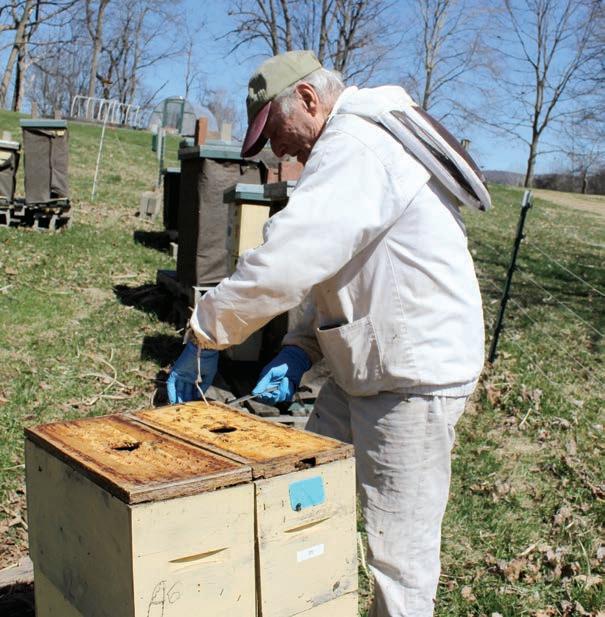
er hive, expecting to find dead bees – he hadn’t seen much activity – he found a number of bees crawling around the frames. That brought his total number of survivors up to 25 nucs, an 80 percent survival



rate. He’s got pretty good bees. “They’ve overwintered here, they’re hardy. They’re anxious to get going this spring. They’re saying, ‘Wow, that was a good winter. We made it.’”




















Hinesburg library hosts 8th annual poetry reading
In celebration of National Poetry Month, local poets, Bethany Breitland, Valerie Koropatnik, Elaine Pentaleri, Marian Willmott and Laura Budofsky Wisniewski will read their work at the Carpenter-Carse Library, 69 Ballards Corner Rd, Hinesburg, on April 27, at 4 p.m.
The event is free and open to the public. Light refreshments and conversation with the poets will follow the reading. The poets’ books will be available for sale. Contact marianw@gmavt.net for more information.
To give you a jump start into the gardening season, Red Wagon Plants, 2408 Shelburne Falls Road, Hinesburg, has put together a day full of workshops and free activities focusing on different aspects of the garden, April 26, starting at 8 a.m.
Workshops range from perennial garden planning and building resilient landscapes to botanizing over spring ephemerals. Free veggie garden demo at 2 p.m.
The event will be accompanied by treats from the Bake Shop and the scent of sweet alyssum in the greenhouses.
Marking over two decades of existence, the Hinesburg Townwide Yard Sale is back, May 10, from 9 a.m.-3 p.m.
Register to appear on the online and print maps at forms.gle/ g9GW68SpCNotyXpX7.
There will be Yard Sale Bingo prizes from local businesses.
Last month, Sarah Frechette, puppeteer and founder of the Vermont-based touring puppet company PuppetKabob, conducted a residency for the Hinesburg Community School’s 5th and 6th graders. The program, “Poems, Puppets & PopUps,” gave students an engaging, challenging and crafty hands-on activity to elevate this year’s writing unit on poetry.
Chosen for both its unique appeal and animatable quality, pop-up cards have a rich history dating back to the 18th century when they were first used as novelty items in books and as greeting cards. For this program, students turned paper cards into moving collages with a theatrical twist.
Prior to this residency the students worked with their writing teachers to develop poems that were used as the inspiration and text for the puppet show. The team, led by writing teacher Ms. Galyean and Mr. Lasher, focused on a magical section from Shakespeare’s “A Midsummer Night’s Dream,” and students wrote a response poem on what important job a fairy might do today.
PuppetKabob introduced the basic principles of paper folding and guided the students through the process of creating two different forms of pop-up mechanisms: right angle v-folds and m-folds.
As a wrap up to this residency, all the combined 5th and 6th classes were mixed up into five new groups and showcased their projects to one another. Between the five classrooms, 98 students participated in the four-day residency.
The Lake Champlain Chamber of Commerce has named Waitsfield and Champlain Valley Telecom Business of the Year.
The telecommunications provider is fourth generation and family owned.
“This award is a reflection of the hard work and dedication of our entire team, and we share it with the customers and communities that have supported us for generations,” telecom president and CEO Eric Haskin said.
The Business of the Year award highlights companies that demonstrate excellence in business practices while making a positive impact on the region. Waitsfield and Champlain Valley Telecom’s continued investment in rural broadband infrastructure and its support of local organizations and events were key factors in this year’s selection.
Hinesburg is preparing for Green Up Day, May 3.
Green-up bags are available at the town hall and Carpenter Carse Library. Green Up day begins Saturday, May 3rd at 8:30 a.m. at the town hall, where you can get more bags and a quick doughnut and sign up for a road section not already taken. Organizers will also have some visibility vests to keep you safe along the roadsides.
Organizers will again use the Sign-Up Genius website to allow volunteers to sign up for different pre-determined road sections to keep track of which roads are getting done and which roads are still available. You can find the

link at tinyurl.com/43zxvxm5.
Green Up your selected road section anytime up to and including Green Up Day. Use the green “Green Up” bags for collected trash and the clear bags for returnable deposit cans and bottles. Bags can be brought to the town
garage, next to the transfer station, between 8:30 a.m.-3:30 p.m. on Green Up Day, or you can leave your collected bags on the roadside where a truck can safely pull over to pick them up.
Make sure your bags are securely tied up. Those bags are
also a visible sign for everyone to see that green up is happing.
No matter when you Green Up, head to the town hall for a community lunch on Green Up Day from





Our half-day summer Math Quest groups engage your child in learning activities and games to show them the fun of numbers in our everyday lives. Designed for rising 5th and 6th graders for one to three weeks.

TOMMY GARDNER STAFF WRITER
A Sunday evening fire in Hinesburg left one person hospitalized with life-threatening injuries, destroyed one home and significantly damaged neighboring homes.
According to a Hinesburg Fire Department press release sent Tuesday night, the department was dispatched on April 20 just before 5:30 p.m. to a fire on Wile Street. Initial reports indicated there was fire in a home with one person reportedly evacuated from the home. The person was reportedly on fire.
Upon arrival, fire fighters discovered the one home on fire and two neighboring homes smoking and almost ablaze. According to the fire department, crews immediately used hoses to attack the in fire the primary structure and protect the adjacent homes, successfully preventing the fire from spreading. Dispatch reported at least one
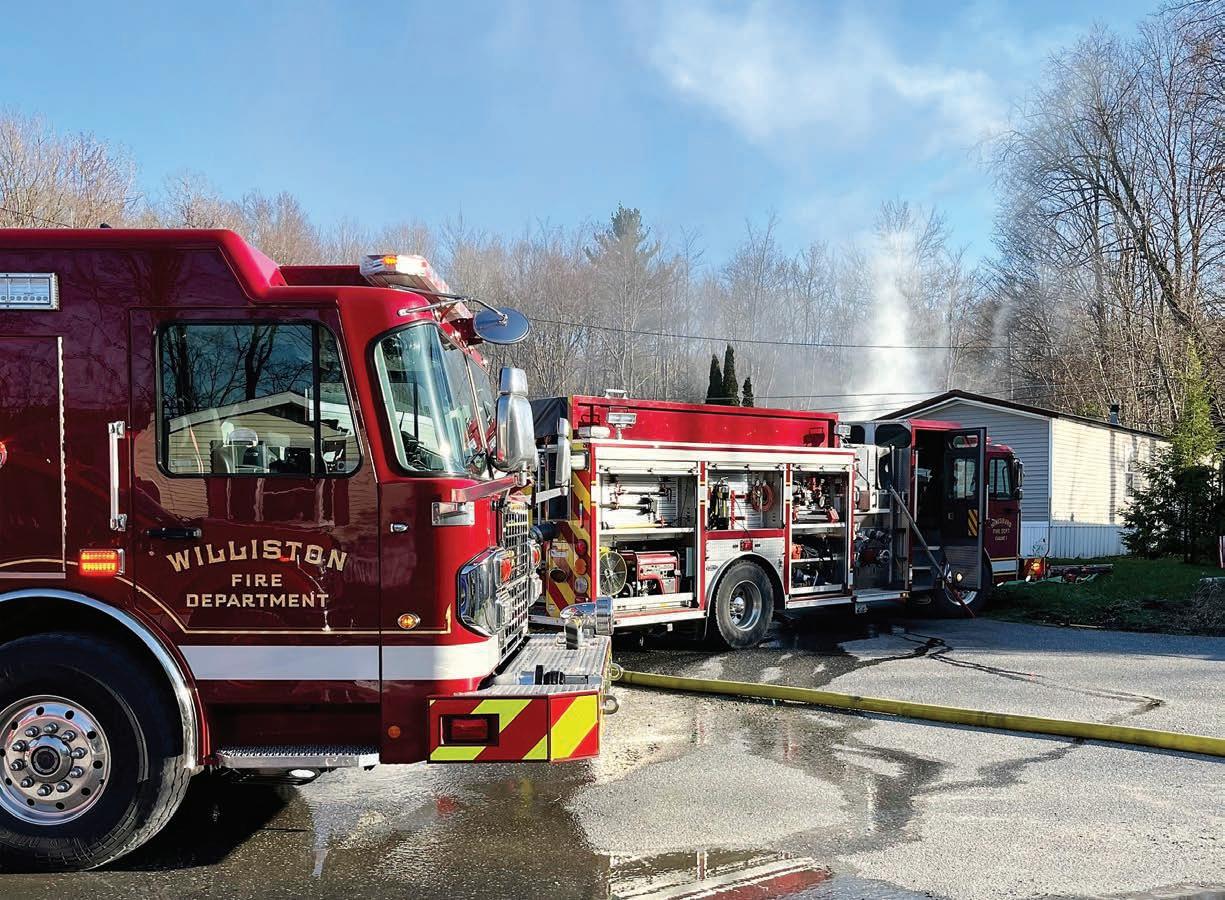
additional home appeared to be on fire, resulting in a third alarm to bring in extra help.
One victim was taken to the hospital with reported life-threatening injuries. Hinesburg Fire
Department stated that, as of Tuesday night, their current condition was unknown. The victim’s name
was not released as of print deadline.


The release stated there were initial reports of a second person possibly inside the home, but fire crews fully searched the home and didn’t find anyone.
The home is considered a total loss and multiple surrounding structures sustained significant damage, according to the department. The fire is under investigation by the Vermont Department of Public Safety and the State Police Fire and Explosion Investigation Unit, but is not considered suspicious.
Mutual aid for the blaze came from Williston, Shelburne, Richmond, Starksboro and Huntington fire departments, as well as EMS assistance from Williston, Richmond, and Charlotte Rescue. Essex Junction Fire Department provided station coverage during the incident.
Hinesburg Fire Department responded with 11 personnel, staffing three engines, one tanker, and one rescue truck.


CORRESPONDENT
Champlain Valley 12, BFA-St. Albans 6: Champlain Valley won its first game of the season, beating BFA-St. Albans on Saturday in high school boys’ lacrosse.
Luke Buehler had three goals and three assists for the Redhawks (1-1), while Will Thomas chipped in with two goals and two assists. Ronan Evans and Charlie Buchwald each added two goals for CVU.
Ethan Whitcomb, Henry Bruneau and Reilly Saylor each had a goal for the Redhawks.
CVU dropped the season’s opening game on Thursday, falling to Middlebury 13-5 in a rematch of last year’s Division I state title game.
Will Thomas and Luke Buehler each had two goals in the loss for CVU, which had a 5-0 lead before falling to the Tigers.
Champlain Valley 17, BFA-St. Albans 5: Rose Bunting’s five goals helped Champlain Valley to a win over BFA-St. Albans on Saturday.
Carly Strobeck added three goals and two assists for the Redhawks, while Mackenzie Love, Heather Pelletier and Maggie Smith each tallied twice.
Skyler Vaughn, Georgia Marcoe and Reesa Bagnato each scored a goal.
Kenna Hutckins and Anya Johnson combined to make six saves in goal for CVU (1-1).
Champlain Valley 10, Milton 6: The Champlain Valley girls Ultimate team won its second game of the season on Thursday, beating Milton 10-6.
Zoey McNabb had six scores to pace the Redhawks, while Abby Bunting added four goals.
Leo Sunderland scored a goal and dished out three assists and Katie Lahiri tallied twice.












continued from page 1
nity. Over the last couple of weeks many of you reached out asking if you could help financially and now there is a true need,” Daudelin said in an email to the community.
Although the debt the family accrued in coming to the United States remains, Daudelin said the community has been able to raise enough funds to cover the cost of their flights.
In the past two weeks, the district and its communities have rallied around the immigration issues students are facing. On Friday, the same day that the district learned the kindergartener would be leaving, Champlain Valley Union High School held a private graduation ceremony for the two high school students. Outside the school, members of the community gathered in support of students and in protest of federal actions affecting schools.
Morgante and others have been regularly protesting the Trump administration’s policies at the intersection of Route 116 and CVU Road, just down the street from the high school, since mid-March. Moving the protest this past week allowed them to focus more on issues facing students.
“We knew beforehand that that these students had been targeted for deportation.”
— Andrea Morgante
Most of the participants last Friday were not necessarily connected personally to the school. According to Morgante, many might have been alums, but most felt the pull to show support for the school and the students, even if they didn’t have a family member currently in attendance.
“We knew beforehand that that these students had been targeted for deportation, so we decided to go and support students on Tuesday morning from 7:45 to about nine o’clock so that as the students were coming into school, they would see us there, and we specifically made signs in support of CVU,” Andrea Morgante, one of the motivating voices behind the protest said.
“It’s the regional high school in our town, so it was kind of a no-brainer for us to extend our protest of what’s happening at the national level to a where it was directly affecting people who are part of our community,” Morgante said.
As school let out and student after student, and bus after bus drove by, the community and the students exchanged cheers and honks, each making sure the other felt seen.
The district declined to comment further on the situation affecting the kindergartener and their family.
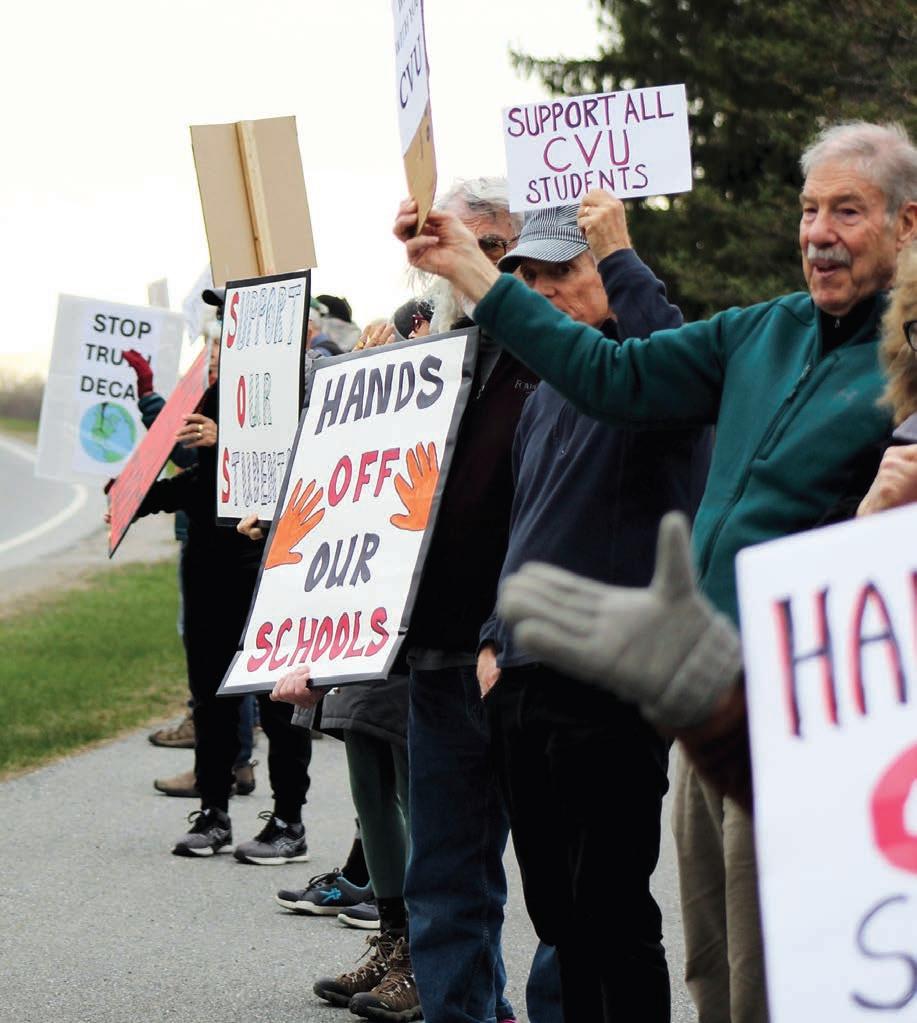









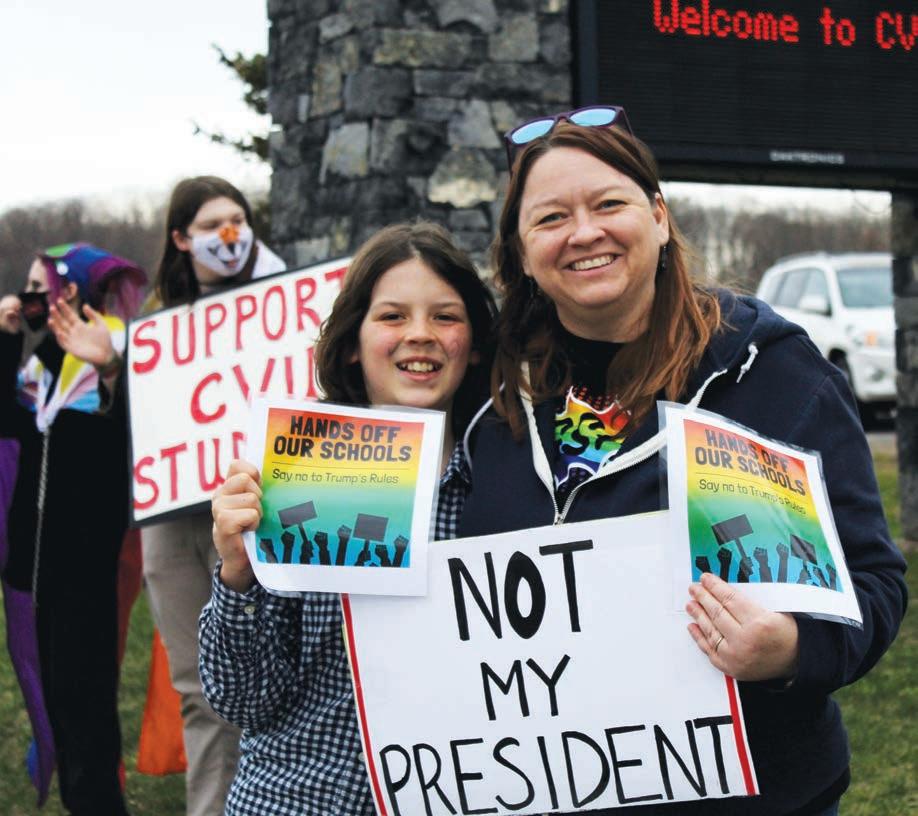
COMMUNITY
continued from page 9
noon-1 p.m.
Safety tips:
• Use extreme caution while on the roadsides, especially with children.
• Wear bright clothing
• When you drop off collected trash at the town garage, a volunteer will show you where it goes.
• Wear gloves and boots
• Take precautions for ticks
Green Up Day 2025 is the 55th anniversary of this state-wide
tradition, and Hinesburg sees up to 100 volunteers participate each year. Many Hinesburg children first learned about civic responsibility through Green Up Day and look forward to this community-wide event to reconnect with their family, friends, and neighbors, according to organizer — and state representative — Phil Pouech.
Email Pouech with at ppouech@gmavt.net.
At NRG Systems, Inc.’s Hinesburg, VT office, Dev & mng frmwr reqs & specs. May work up to 2 days/wk from a home office that is commutable to physical work location.
potentially fatal disease.
Rabies is a deadly viral disease of the brain that infects mammals. It is most often seen in raccoons, skunks, foxes, and bats, but unvaccinated pets and livestock can also get rabies.The virus is spread through the bite of an infected animal or contact with its
Salary: $114,000 – $144,000. Send resume with Job ID SK-2025 to L. West@lmw@nrgsystems.com.
saliva. If left untreated, rabies is almost always fatal in humans and animals. However, treatment with the rabies vaccine is nearly 100 percent effective when given soon after a person is bitten by a rabid animal.
So far this year, 23 animals in Vermont have tested positive for rabies, and 14 of those have been raccoons.
According to wildlife officials, rabid animals often show a change in their normal behavior, but you cannot tell whether an animal has rabies simply by looking at it. People should not touch or pick up wild animals or strays – even baby animals.




SHELBURNE continued
Shelburne display lead a cemetery dors round from coffee creemees. from





















Thursday, 5/8 from 5-6pm at Rice
Learn about our academic programs, meet our teachers, and see what sets Rice apart. Talk to current parents and ask questions in a no-pressure setting. RSVP using the QR code below. We look forward to meeting you!
of families



bessette@rmhsvt.org
rmhsvt.org


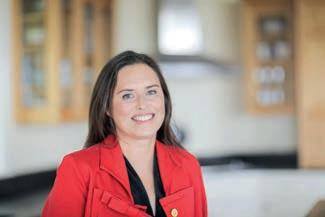
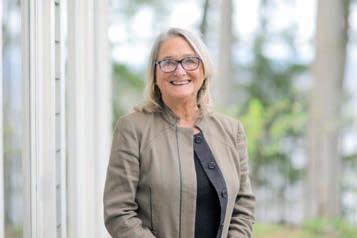

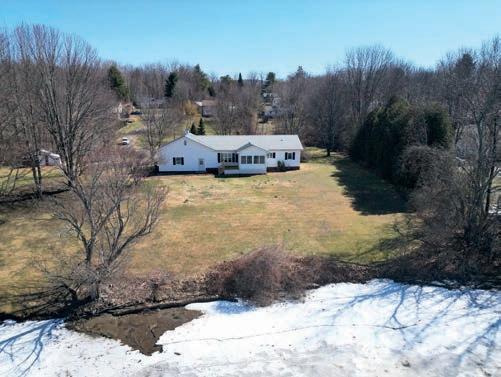





WEINBERGER continued from page 5
ago, we’re taking on one of the biggest barriers: reforming the outdated maps and rules under Act 250 that limit where and how we can grow.
This isn’t going to be easy. Already, we can see new groups forming that want to continue the politics of blocking. We must push ourselves to grow in a way that respects our cherished natural landscape and is better than the development we have seen in other parts of the country. Vermont’s future depends on finding this balance.
But make no mistake: If we are going to end homelessness, be a state where young families can get a start, provide all our kids a good education, enjoy high quality health care throughout the state — if we want a future of abundance, not scarcity — we are going to have to grow.
The alternative is a Vermont that becomes increasingly unaffordable, where only the wealthy or those receiving aid can live, where our schools continue to empty, where our rural communities are hollowed out, where our workforce shortage worsens
continued from page 5
line, choosing a slightly delayed deadline year with a pollution reduction requirement that follows the curve downward, which would maintain accountability.
This offer remains, but the first step must come from the governor. If he has a substantive, meaningful plan for getting Vermont back on track, I’m ready to listen and work together.
For the vast majority of cases, the renewable option is cheaper than its fossil fuel alternative. If Gov. Scott is serious about energy affordability, he’d be finding a way to transition Vermonters off expensive, price volatile, foreign fossil fuels.
What’s concerning is the governor’s continued pattern of resistance and a lack of initiative, even as energy costs fluctuate and the need to transition off fossil fuels becomes more urgent. This moment calls for leadership that embraces both the finan-
and where more Vermonters find themselves without homes. That’s not the Vermont any of us want.
The politics of abundance requires courage. It means standing up to voices that reflexively say no. It means embracing change while being thoughtful about how we manage it. It means creating new systems for government decisions and action that prioritize results and speed over undue process.
Let’s Build Homes is committed to leading this transition from a state of blocking to a state of building. Join us in creating a Vermont where everyone can find a place to call home. Join the coalition at letsbuildhomes.org.
Miro Weinberger was the Mayor of Burlington from 2012 to 2024. He is currently serving as the executive chair of Let’s Build Homes and as a Visiting Fellow at the Harvard Kennedy School of Government Taubman Center for State and Local Government.
cial and scientific realities before us. The affordable, resilient energy future Vermonters need is within reach, but only if we’re willing to take bold, concrete steps.
Gov. Scott, Vermont needs you to bring forward a serious, actionable climate plan that gets us back on track toward necessary climate pollution reductions, that gets us back on the path toward energy affordability. If you do, I’ll be the first to recognize and support that effort.
But in the absence of such a plan, we must stay the course for the 2030 deadline. We all want a future in which energy is cheap, locally produced and not polluting our planet, and we need leadership that will get us there.
Washington County Sen. Anne Watson is chair of the Senate Committee on Natural Resources and Energy.







